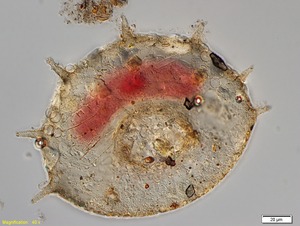Protozoa
In some systems ofbiological classification, theProtozoa are a diverse group of unicellulareukaryoticorganisms.[1]Historically, protozoawere defined as single-celled organisms withanimal-like behaviours, such as motility andpredation. The group was regarded as the zoological counterpart to the "protophyta", which were considered to be plant-like, as they are capable ofphotosynthesis.[2] The terms protozoaand protozoans are also used informally to designate single-celled, non-photosynthetic protists, such asciliates, amoebae and flagellates.
The term Protozoa was introduced in 1818 for a taxonomic class,[3] but in later classification schemes the group was elevated to higher ranks, includingphylum, subkingdom and kingdom. In several classification systems proposed by Thomas Cavalier-Smithand his collaborators since 1981, Protozoa is ranked as a kingdom.[4][5][6] The seven-kingdom scheme proposed by Ruggiero et al. in 2015, places seven phyla under Protozoa: Euglenozoa, Amoebozoa,Choanozoa, Loukozoa, Percolozoa,Microsporidia and Sulcozoa.[7] This kingdom does not form a clade, but anevolutionary grade or paraphyleticgroup, from which the fungi and animals are specifically excluded.
The use of Protozoa as a formal taxonhas been discouraged by some researchers, mainly because the term, which is formed from the from the Greek protos "first" + zoia, plural ofzoion, "animal", misleadingly implies kinship with animals (metazoa)[8][9]and promotes an arbitrary separation of "animal-like" from "plant-like" organisms.[10] Modern ultrastructural, biochemical, and genetic techniques have shown that protozoa, as traditionally defined, belong to widely divergent lineages, and can no longer be regarded as "primitive animals." For this reason, the terms "protists," "Protista" or "Protoctista" are sometimes preferred for the high-level classification of eukaryotic microbes. In 2005, members of the Society of Protozoologists voted to change the name of that organization to the International Society of Protistologists.[11]
Contents
[hide]History and terminology[edit]
The word "protozoa" (singularprotozoon, or protozoan) was coined in 1818, by zoologist Georg August Goldfuss, as the Greek equivalent of the German "Urthiere," meaning "primitive, or original animals". Goldfuss erected Protozoa as a classcontaining what he believed to be the simplest animals. Originally, the group included not only microbes, but also some "lower" multicellular animals, such as rotifers, corals, sponges,jellyfish, bryozoa and polychaete worms.[3]
In 1848, in light of advancements incell theory pioneered by Theodore Schwann and Matthias Schleiden, the anatomist and zoologist C.T. von Siebold proposed that the bodies of microbial organisms such as ciliatesand amoebae were made up of single cells, similar to those from which the multicellular tissues of plants and animals were constructed. Von Siebold redefined Protozoa to include only such unicellular forms, to the exclusion of all metazoa.[12] At the same time, he raised the group to the level of aphylum containing two broad classes of microbes: Infusoria (mostly ciliates and flagellated algae), and Rhizopoda (amoeboid organisms). The definition of Protozoa as a phylum or sub-kingdom made up of "unicellular animals" was adopted by the zoologistOtto Bütschli—celebrated at his centenary as the "architect of protozoology"[13]—and the term came into wide use.
As a phylum under Animalia, the Protozoa were firmly rooted in the old "two-kingdom" classification of life, according to which all living beings were classified as either animals or plants. As long as this scheme remained dominant, the protozoa were understood to be animals and studied in departments of Zoology, while photosynthetic microbes and microscopic fungi—the so-called Protophyta—were assigned to the Plants, and studied in departments of Botany.[14]
Criticism of this system began in the latter half of the 19th century, with the realization that many organisms met the criteria for inclusion among both plants and animals. For example, the algae Euglena and Dinobryon havechloroplasts for photosynthesis, but can also feed on organic matter and are motile. In 1860, John Hogg argued against the use of "protozoa", on the grounds that "naturalists are divided in opinion—and probably some will ever continue so—whether many of these organisms, or living beings, are animals or plants." [15] As an alternative, he proposed a new kingdom called Primigenum, consisting of both the protozoa and unicellular algae (protophyta), which he combined together under the name "Protoctista". In Hoggs's conception, the animal and plant kingdoms were likened to two great "pyramids" blending at their bases in the Kingdom Primigenum.
Six years later, Ernst Haeckel also proposed a third kingdom of life, which he named Protista. At first, Haeckel included a few multicellular organisms in this kingdom, but in later work he restricted the Protista to single-celled organisms, or simple colonies whose individual cells are not differentiated into different kinds of tissues.
Despite these proposals, Protozoa emerged as the preferred taxonomic placement for heterotrophic microbes such as amoebae and ciliates, and remained so for more than a century. In the course of the 20th century, however, the old "two kingdom" system began to weaken, with the growing awareness that fungi did not belong among the plants, and that most of the unicellular protozoa were no more closely related to the animals than they were to the plants. By mid-century, some biologists, such as Herbert F. Copeland, Robert H. Whittaker andLynn Margulis, advocated the revival of Haeckel's Protista or Hogg's Protoctista as a kingdom-level eukaryotic group, alongside Plants, Animals and Fungi.[14] A variety ofmulti-kingdom systems were proposed, and Kingdoms Protista and Protoctista became well established in biology texts and curricula.[16][17][18]
While many taxonomists have abandoned Protozoa as a high-level group, Thomas Cavalier-Smith has retained it as a kingdom in the various classifications he has proposed. As of 2015, Cavalier-Smith's Protozoa excludes several major groups of organisms traditionally placed among the protozoa, including the ciliates,dinoflagellates and foraminifera (all members of the SAR supergroup). In its current form, his kingdom Protozoa is a paraphyletic group which includes a common ancestor and most of its descendents, but excludes two important clades that branch within it: the animals and fungi.[7]
Characteristics[edit]
Protozoa, as traditionally defined, are mainlymicroscopicorganisms, ranging in size from 10 to 52 micrometers. Some, however, are significantly larger. Among the largest are the deep-sea dwellingxenophyophores, single-celled foraminifera whose shells can reach 20 cm in diameter.[19] Free-living forms are restricted to moist environments, such as soils, mosses and aquatic habitats, although many form resting cysts which enable them to survive drying. Many protozoan species aresymbionts, some are parasites, and some are predators of bacteria, algaeand other protists.
Motility and feeding[edit]
Organisms traditionally classified as protozoa are abundant in aqueousenvironments and soil, occupying a range of trophic levels. The group includes flagellates (which move with the help of whip-like structures calledflagella), ciliates (which move by using hair-like structures called cilia) andamoebae (which move by the use of foot-like structures calledpseudopodia). Some protozoa aresessile, and do not move at all.
Protozoa may take in food byosmotrophy, absorbing nutrients through their cell membranes; or they may feed by phagocytosis, either by engulfing particles of food with pseudopodia (as amoebae do), or taking in food through a mouth-like aperture called a cytostome. All protozoa digest their food in stomach-like compartments called vacuoles.[20]
Pellicle[edit]
The pellicle is a thin layer supporting the cell membrane in various protozoa, such as ciliates, protecting them and allowing them to retain their shape, especially during locomotion, allowing the organism to be morehydrodynamic. The pellicle varies from flexible and elastic to rigid. Although somewhat stiff, the pellicle is also flexible and allows the protist to fit into tighter spaces. In ciliates andApicomplexa, it is formed from closely packed vesicles called alveoli. Ineuglenids, it is formed from proteinstrips arranged spirally along the length of the body. Familiar examples of protists with a pellicle are theeuglenoids and the ciliate Paramecium. In some protozoa, the pellicle hostsepibiotic bacteria that adhere to the surface by their fimbriae or "attachment pili".[21]
Ecological role[edit]
As components of the micro- andmeiofauna, protozoa are an important food source for microinvertebrates. Thus, the ecological role of protozoa in the transfer of bacterial and algal production to successive trophic levelsis important. As predators, they prey upon unicellular or filamentous algae,bacteria, and microfungi. Protozoan species include both herbivores andconsumers in the decomposer link of the food chain. They also control bacteria populations and biomass to some extent. On average, protozoa eat ~ 100 to 1,000 bacteria per hour.[citation needed] Some protozoa, such as the malaria parasites (Plasmodium spp.), trypanosomes andleishmania, are important disease-causing agents in humans. Protozoa can stimulate decomposition of organic matter, digest cellulose in therumen of cows and termite guts, and can play a role in nutrient mobilization.[citation needed]
Life cycle[edit]
Some protozoa have life phases alternating between proliferative stages (e.g., trophozoites) and dormant cysts. As cysts, protozoa can survive harsh conditions, such as exposure to extreme temperatures or harmful chemicals, or long periods without access to nutrients, water, or oxygen for a period of time. Being a cyst enables parasitic species to survive outside of a host, and allows their transmission from one host to another. When protozoa are in the form of trophozoites (Greek, tropho = to nourish), they actively feed. The conversion of a trophozoite to cyst form is known as encystation, while the process of transforming back into a trophozoite is known as excystation. Protozoa reproduce asexually bybinary fission or multiple fission. Many protozoan species exchange genetic material by sexual means (typically, through conjugation); however, sexuality is generally decoupled from the process of reproduction, and does not immediately result in increased population.[22]
Classification[edit]
Further information:wikispecies:Protozoa
The classification of protozoa has been and remains a problematic area of taxonomy. Where they are available, DNA sequences are used as the basis for classification but for the majority of described protozoa such material is not available. They have been and still are mostly on the basis of their morphology and for the parasitic species their hosts. Protozoa have been divided traditionally[citation needed]on the basis of their means of locomotion.
- Flagellates (e.g., Giardia lamblia)
- Amoeboids (e.g., Entamoeba histolytica)
- Sporozoans (e.g., Plasmodium knowlesi)
- Apicomplexa (now in Alveolata)
- Microsporidia (now in Fungi)
- Ascetosporea (now in Rhizaria)
- Myxosporidia (now in Cnidaria)
- Ciliates (e.g., Balantidium coli)
As a phylum the Protozoa were, historically, divided into four subphyla[23] reflecting the means of locomotion:
- Subphylum Sarcomastigophora
- Superclass Mastigophora (includes flagellates)
- Superclass Sarcodina
- Superclass Opalinata
- Subphylum Sporozoa (includes apicomplexans)
- Class Microsporidea
- Subphylum Ciliophora (includes ciliates)
These systems are no longer considered to be valid.
Human disease[edit]
Main article: Protozoan infection
Some protozoa are human parasites, causing diseases including Malaria,Amoebiasis, Giardiasis,Toxoplasmosis, Cryptosporidiosis,Trichomoniasis, Chagas disease,Leishmaniasis, Sleeping Sickness,Amoebic dysentery, Acanthamoeba Keratitis, and Primary Amoebic Meningoencephalitis.
Animal disease[edit]
The protozoan Ophryocystis elektroscirrha is a parasite of butterflies. It infects the butterfly entering the larval stage. The spores are found on the body of infected butterflies. These spores are passed, from female to caterpillar. Severely infected individuals are weak, unable to expand their wings, or unable to eclose, and have shortened lifespans, but parasite levels vary in populations. This is not the case in laboratory or commercial rearing, where after a few generations, all individuals can be infected.[24] Infection with this parasite creates an effect known as cullingwhereby infected migrating animals are less likely to complete the migration. This results in populations with lower parasite loads at the end of the migration.[25]







No comments:
Post a Comment